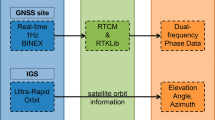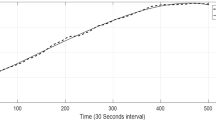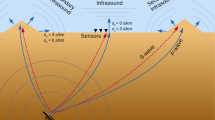Abstract
OBSERVATIONS on the horizontal movements in the F-region of the ionosphere by radio methods using the pulse method of ionospheric sounding, and also by employing a precision direction-finding technique, have been made during the past few years1–7. The present communication reports the results of recent investigations on travelling disturbances in the ionosphere obtained by a new and simple method in which use has been made of the continuous-wave radio signals from a distant short-wave transmitter.
This is a preview of subscription content, access via your institution
Access options
Subscribe to this journal
Receive 51 print issues and online access
$199.00 per year
only $3.90 per issue
Buy this article
- Purchase on Springer Link
- Instant access to full article PDF
Prices may be subject to local taxes which are calculated during checkout
Similar content being viewed by others
References
Nature, 167, 626 (1951).
Ross, W., Nature, 166, 1011 (1950).
Ross, W., and Bramley, E. N., Proc. Roy. Soc., A, 207, 251 (1951).
Munro, G. H., Nature, 162, 886 (1948).
Munro, G. H., Nature, 163, 812 (1949).
Munro, G. H., Proc. Roy. Soc., A, 202, 208 (1950).
Reynon, W. J. G., Nature, 162, 887 (1948).
Author information
Authors and Affiliations
Rights and permissions
About this article
Cite this article
SOMAYAJULU, Y. Investigation of Travelling Disturbances in the Ionosphere by Continuous-Wave Radio. Nature 172, 818–819 (1953). https://doi.org/10.1038/172818a0
Issue Date:
DOI: https://doi.org/10.1038/172818a0
This article is cited by
-
Über Driftmessungen mit Hilfe von Langwellenausbreitungsmessungen
Geofisica Pura e Applicata (1962)
Comments
By submitting a comment you agree to abide by our Terms and Community Guidelines. If you find something abusive or that does not comply with our terms or guidelines please flag it as inappropriate.



